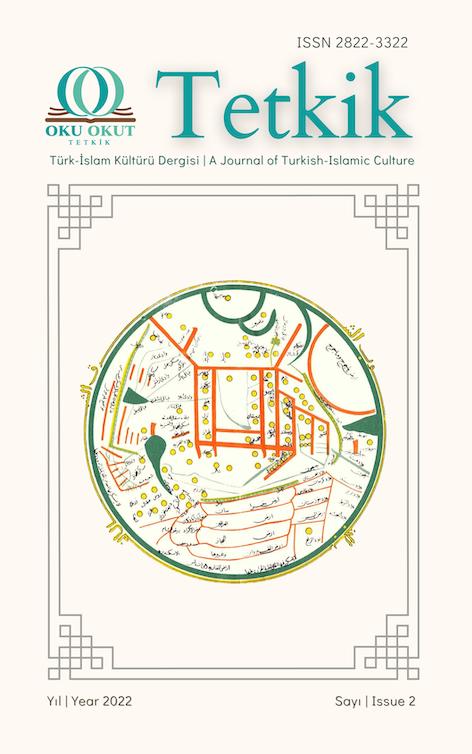Author(s): Yunus İşeri / Language(s): Turkish
Issue: 2/2022
Concepts are the key to the world of meanings, which include many senses. Knowing the soundness of ḳirāʾāts and understanding certain issues connected to ḳirāʾāt views that was conveyed have importance since it is both related to Qur‘an and ḳirāʾāt dicipline. Conceptionally, the necessity to go into ḳirāʾāts breeds because studying on concepts related to variations of recitations concerned about its dicipline puts across the issue thoroughly. Therefore, recitation kinds are terminologically accounted for its accuracy in this article. Our research, which deals with the types of ḳirāʾāts, reveals which terms related to the subject are used to express the readings that fall into the scope. It also gave place to different opinions among scholars on this subject. However, while evaluating the types of recitation, the prominent views and conceptual approaches of the early ḳirāʾāt authorities were taken as the basis. Thus, it is aimed to reach more robust information on the subject. Because, while the science of recitation is systematized and matured on certain foundations, the period of narration, compilation and classification has an undeniable importance in reaching more accurate information about the subject. The main purpose of this research is to contribute to the enlightenment of some closed points related to the types of ḳirāʾāts, which are understood to have not reached a certain clarity in the ḳirāʾāt literature. Regarding the concepts used about the types of ḳirāʾāt, first of all, the main sources of the field were consulted, and the meaning of the terms in this subject was revealed with examples from time to time. Comparisons were made between the concepts related to the subject, and the reason for the confusion between some concepts was mentioned. Then, the accuracy of the types of ḳirāʾāts is discussed within the framework of the views of the scholars who are accepted as the authority in the science of ḳirāʾāt. Although the first-term ḳirāʾāt scholars approached to recitations similarly, the accuracy of recitation views, reading situation of valid ḳirāʾāt imams, whether some recitations are accurate, issues such as these are discussed. Ḳirāʾāts are divided into acceptable and unacceptable. For acceptable recitations, the concepts of mutawatir, sahîh and famous are used. The concepts of mutawatir, ṣaḥîḥ and mashoor are used for acceptable ḳirāʾāts. There are different approaches as to one ḳirāʾāt is either valid or rumour. When the basic works of recitation literature are examined, the concepts of ṣaḥîḥ, mutawatir and mashoor ḳirāʾāt, which are seen to be used for acceptable ḳirāʾāts, have been compared with the same concepts of hadith science, leading to a negative approach to some authentic recitations. However, the prominent point in the ancient sources of the field is that these three concepts were used for authentic readings. On the other hand, while the mashoor ḳirāʾāt expression in the first period ḳirāʾāt works meant ṣaḥîḥ ḳirāʾāts, which gained popularity and were also known by the majority of ḳirāʾāt imams and narrators, this concept was perceived by some as a type of ḳirāʾāt in the later period. There are also some types of ḳirāʾāt that do not meet the health conditions of ḳirāʾāt, although it is included in some sources. These were named as shâzz, ahad, mawzû or mudrec, based on the way the ḳirāʾāt is conveyed, or the mushaf line and its agreement with Arabic. The term shâzz has been used as a roof concept for such undesirable ḳirāʾāts. Ahâd ḳirāʾāt and mudrec ḳirāʾāt, which are types of shâzz ḳirāʾāt, which do not meet the three criteria required for a ḳirāʾāt vechine to be accepted, differ from the others. Some of the recitation aspects included in these two types of ḳirāʾāt were not accepted as the Qur'an because they were not suitable for the mushaf line agreed by the Companions, although they were in accordance with the Arabic language and were also transmitted with sound proofs. It may be possible that these are from the Ahruf-u-seb'a mentioned in the hadiths. However, even if they are authentic, they do not comply with the mushaf line. Therefore, it was stated that they were abrogated in the last Arda, and these two types of ḳirāʾāt were accepted as shâzz. Müdrac ḳirāʾāts were also evaluated in two ways. First: They may have been abrogated even though they were among the ḳirāʾāts read before. Second: It is possible that these are the tafsir multiplicities found in the special companion mushafs. Although valid ḳirāʾāts in old recitation works are ment as mashoor recitations, this concept is thought as a ḳirāʾāt kind in the later term. There are some ḳirāʾāt kinds which do not have valid ḳirāʾāt features despite that they are in a few sources. These are shâzz, âhâd, müdrac in the confrontation of issues such as its conveying way, Qur‘an and Arabian but shâzz is used as a main term for these ḳirāʾāts. In this article, some misunderstood points will be explained, by focusing on the center of old pieces about ḳirāʾāt kinds and the accuracy of valid ḳirāʾāts will be taken in hand, mentioning about the connections in concepts, whic include meanings and senses. In this context, it will be spoken to the concepts that recitations scholars use to remark ḳirāʾāt kinds and their definitons. Lastly, different approaches will be analyzed
More...










